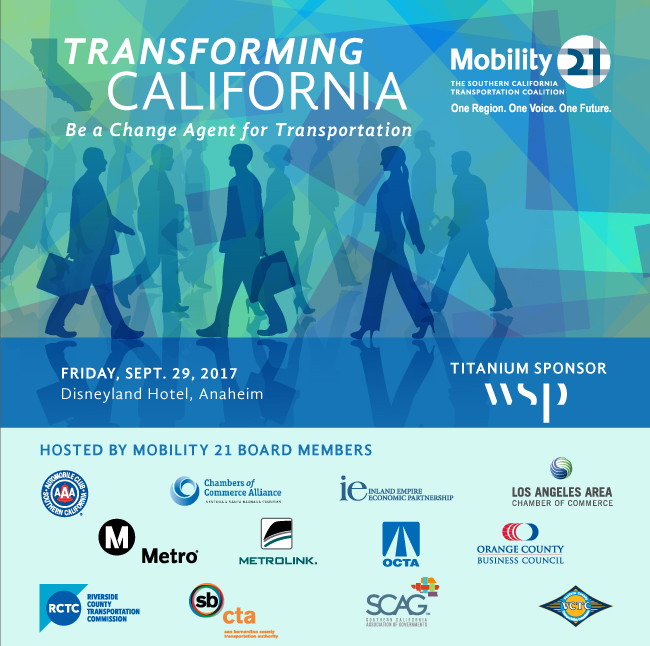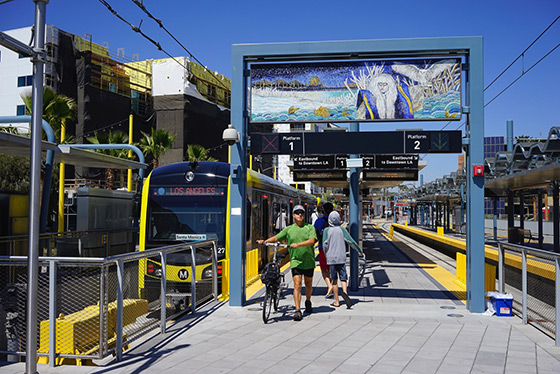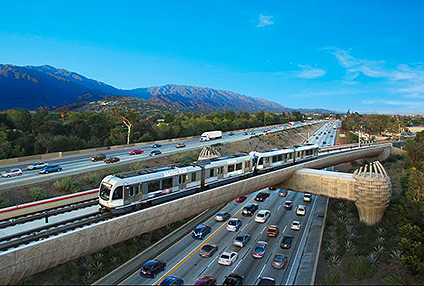Register Now for the Mobility 21
Summit and Save $100
Join more than 1,100 transportation stakeholders, industry leaders and elected officials on Friday, Sept. 29 at the Disneyland Hotel at the 2017 Mobility 21 Summit – California’s largest one-day transportation event. Hurry, Early Bird registration ends Aug. 11!
Registration Rates
Early Bird Registration: $295
Registration after Aug. 11: $395
Student/Military Personnel Registration: $175 (does not include twilight Disneyland ticket)
Click here to register online!
Sponsor the Summit Today
The Summit is the only place where you can mix and mingle with every transportation CEO in Southern California, policy makers and nationally-known transportation experts. Click here to view the sponsorship packages.
Reduced Hotel Rate Reservations
Discount hotel rates are available to conference attendees! Click here to reserve your room now. Space is limited and the discount is only available until it’s sold out or Tuesday, Aug. 29
Mobility 21 Advisory Board Member Spotlight:
Mark Baza
Executive Director, Imperial County Transportation Commission
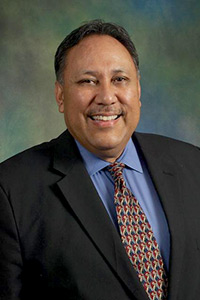 In June 2010, Mark Baza was appointed as the Executive Director of the Imperial County Transportation Commission (ICTC). ICTC is the Regional Transportation Planning and Transit Agency for Imperial County. ICTC recently celebrated its 7th Anniversary as it was established as a County Transportation Commission in 2009 under Senate Bill 607 (Ducheny) and became a new agency effective January 1, 2010. Under the direction of the Commission, Baza has led the development of the new agency’s organizational structure, staffing and work programs. ICTC is one of six County Transportation Commissions within the Southern California Association of Governments (SCAG) region. SCAG is the federally mandated Metropolitan Planning Organization (MPO) for the six counties and as is recognized as the largest MPO in the United States.
In June 2010, Mark Baza was appointed as the Executive Director of the Imperial County Transportation Commission (ICTC). ICTC is the Regional Transportation Planning and Transit Agency for Imperial County. ICTC recently celebrated its 7th Anniversary as it was established as a County Transportation Commission in 2009 under Senate Bill 607 (Ducheny) and became a new agency effective January 1, 2010. Under the direction of the Commission, Baza has led the development of the new agency’s organizational structure, staffing and work programs. ICTC is one of six County Transportation Commissions within the Southern California Association of Governments (SCAG) region. SCAG is the federally mandated Metropolitan Planning Organization (MPO) for the six counties and as is recognized as the largest MPO in the United States.
As the regional transportation planning agency for Imperial, ICTC is responsible to plan and develop the regional and state highway network in partnership with the California Department of Transportation (Caltrans), California Transportation Commission, Federal Highway Administration (FHWA) and SCAG. Together, key regional highway improvements have been completed and are underway.
To improve trade corridor improvements at the land ports of entry (LPOEs) with Mexicali, Mexico, Mark has led an effort to establish the Imperial-Mexicali Binational Alliance. Mexico is California’s top trading partner and in 2012 there was an estimated $12.5 Billion in trade through the Calexico East/Mexicali II LPOE. Across all Imperial-Mexicali LPOEs approximately 40,000 people from Mexicali, Mexico legally cross northbound into the U.S. daily and are vital to Imperial County and California’s economy. In 2012, the binational workgroup began meeting monthly to plan and implement cross-border transportation infrastructure investments; environment and air quality improvements; and, marketing of economic development opportunities and investments. In 2013, the Alliance was institutionalized through a bilateral Memorandum of Understanding (MOU) signed by local, state and federal entities of Mexico and the U.S. The Alliance now meets bi-monthly, rotating locations in Mexicali and Imperial with over 40 stakeholder agencies providing updates on projects in the core areas of border infrastructure, environment and economic development.
As the regional transit agency, ICTC plans and operates the Imperial Valley Transit which includes fixed route public transit services, paratransit services, and dial-a-ride services throughout the county. Since 2012, ICTC has purchased and now owns its fleet of transit vehicles. Other accomplishments include: increasing express route services; expanded hours of service on Saturdays; all new limited schedule of service on Sundays; planning and design of intra-city bus services in the cities of Brawley, Imperial and Calexico; completion of transit centers (transfer terminals) at Imperial Valley College, the cities of Brawley and El Centro; and, conceptual plans were completed for a large new Intermodal Transit Center (ITC) in the City of Calexico. The Calexico ITC proposes to serve public and private transit shuttle operators, Greyhound bus operations, farm labor buses and taxi service.
Additionally, ICTC administers the County’s “Measure D” half-cent sales tax program. As one of twenty “Self Help Counties” in California, ICTC distributes the lion’s share of the Measure D funds to each of the seven cities and County of Imperial to complete local road pavement rehabilitation projects; improve pedestrian and bicycle access; improve access as required by the Americans with Disabilities Act (ADA); and local road operational improvements. The Measure D program also provides local contributions to state highway and transit projects.
Mr. Baza has 26 years of experience in the transportation planning and engineering industry. Prior to his position at ICTC, Mark began his career with the California Department of Transportation (Caltrans) District 11 for over 20 years. At Caltrans, Mark had lead responsibilities for regional and goods movement planning in San Diego and Imperial counties. Later served as Project Manager for a portfolio of planning and capital projects to improve goods movement in Southern California and, ground access to all of California’s land ports of entry with Mexico and the Port of San Diego’s seaport terminals. At Caltrans, Mark had worked in the Division’s of Planning, Program/Project Management, and last position as Project Manager for the State Route 11 and Otay Mesa East Port of Entry project, a new state highway, California Highway Patrol (CHP) truck inspection facility and federal land port of entry; and, other Trade Corridor Improvement Fund (TCIF) projects for Caltrans District 11.
Mr. Baza earned a Bachelor’s degree in Urban Planning and Studies from the University of California, San Diego and completed a post-graduate Certificate Program in Transportation Planning for Air Quality at the University of California, Riverside.
Mobility 21 Advisory Board Member Spotlight:
David Warner
Senior Vice President, Southern California Infrastructure Leader, Parsons
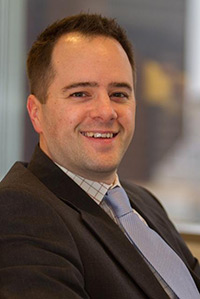 Dave is responsible for partnering with regional leaders, stakeholders, and clients to strategically advance infrastructure in Southern California. He guides Parsons’ investment in the region through business development, political engagement, and professional organization participation in order to provide top talent, innovative solutions, and emerging technologies to Parsons’ clients and projects. Dave is a senior vice president who has been in charge of Parsons’ California operations for the last two years. He is serving as principal-in-charge for several of the region’s largest transportation projects and leading Parsons’ efforts for public-private-partnerships in Los Angeles.
Dave is responsible for partnering with regional leaders, stakeholders, and clients to strategically advance infrastructure in Southern California. He guides Parsons’ investment in the region through business development, political engagement, and professional organization participation in order to provide top talent, innovative solutions, and emerging technologies to Parsons’ clients and projects. Dave is a senior vice president who has been in charge of Parsons’ California operations for the last two years. He is serving as principal-in-charge for several of the region’s largest transportation projects and leading Parsons’ efforts for public-private-partnerships in Los Angeles.
Dave has been active in various professional organizations; serving as a board member for the American Council of Engineering Companies, Los Angeles Area Chamber of Commerce, and Orange County Business Council.
Dave has a broad background in project delivery that includes planning and policy through construction and alternative project delivery for waterfront, roadway, and transit projects. In Dave’s prior role, he managed the environmental phase for the world’s longest floating bridge, managed the delivery of the world’s longest urban seawall replacement, and served on Seattle Mayor’s Office appointed Women- and Minority- Owned Businesses Advisory Committee to significantly advance the region’s commitment to diverse and inclusive business opportunities. His collaborative approach to operations, sales, and project delivery will further Parsons’ innovation and energy around infrastructure in the region.
Summit Titanium Sponsor Spotlight:
WSP USA
 At WSP USA, formerly WSP | Parsons Brinckerhoff, our expertise lies at the intersection of the infrastructure and the skylines we have helped to shape from coast to coast. We have planned, designed and managed the construction of some of the most iconic buildings, bridges, highways, tunnels, and transit and rail systems across the U.S. With nearly 36,000 people globally and 100 offices across the U.S., including eight in California, we are locally dedicated with international scale, and can connect you with technical experts in every aspect of the built environment.
At WSP USA, formerly WSP | Parsons Brinckerhoff, our expertise lies at the intersection of the infrastructure and the skylines we have helped to shape from coast to coast. We have planned, designed and managed the construction of some of the most iconic buildings, bridges, highways, tunnels, and transit and rail systems across the U.S. With nearly 36,000 people globally and 100 offices across the U.S., including eight in California, we are locally dedicated with international scale, and can connect you with technical experts in every aspect of the built environment.
We offer cross-disciplinary services across multiple markets including: advisory; buildings; water and environment; energy; and transportation. Some of our most notable projects include major expansions of the New York, Los Angeles and San Francisco transit systems, construction of iconic buildings such as One World Trade Center in New York City, and modernization of Chicago’s O’Hare International Airport.
For more than 30 years we have served local communities in Southern California as engineers, planners, strategic advisors and construction management professionals. Our expertise has been applied to several major transit, aviation and roadway projects, such as the Metro Purple Line subway, Metro Regional Connector, Mid-Coast Transit Corridor, California High Speed Rail, Expo Phase 2 transit expansion, the LAX Landside Access Modernization Program, and the SBCTA I-15 Corridor Project.
Learn more about what we do at www.wsp.com or contact our Southern California area managers: Lisa Maurath (Los Angeles), Vic Martinez (Orange/Inland Empire), or Rex Plummer (San Diego).
Earlier this month the Metro Board approved the budget and project agreements to build the second phase of the Foothill Gold Line Project.
First Metro Measure M Transit Project
Gets Green Light
The Los Angeles County Metropolitan Transportation Authority (Metro) Board approved a $1.4-billion budget and partnership agreements to extend the Metro Gold Line in the San Gabriel Valley another 11.5 miles east to Claremont.
Partnership agreements establish a funding plan and shared roles and responsibilities between Metro and the Foothill Gold Line Construction Authority, the agency that will build the extension. Metro will fund the portion of the new segment from Glendora to Claremont within Los Angeles County. The Construction Authority plans to utilize other funding to complete the line to Montclair in San Bernardino County as part of the overall project.
The extension will be the first rail line to begin construction from a multitude of new transit projects funded by Metro’s Measure M half-cent transportation sales tax approved by L.A. County voters in November 2016.
“This second phase of the Foothill Gold Line is truly significant because it’s the very first Measure M transit project out of the gate,” said John Fasana, Metro Board Chair and Mayor Pro Tem for the city of Duarte. “It will establish the early momentum we need to launch our ambitious new traffic improvement plan that will yield tremendous transportation benefits for the entire Los Angeles County area.”
Under the terms of the funding agreement, Metro will use Measure M and other local and state funds to pay for construction. Metro plans to apply for a $249-million grant from the state’s Transit and Intercity Rail Capital Program to complete life-of-project budget requirements. Should that funding be unavailable, Metro will pursue other options and approaches to meet the full funding needs of the project. The Board also approved the transfer of an additional $26 million in cost savings from the Construction Authority’s Gold Line segment to Azusa, which opened in March 2016. Combined with previously approved savings, nearly $100 million of residual Measure R funds dedicated for the full Foothill Gold Line project will be used to complete the next segment from Glendora to Claremont.
“Today is a major milestone for our agency and the residents, students and workers of the project’s corridor cities who eagerly await the Gold Line’s arrival,” said Doug Tessitor, Chairman of the Construction Authority Board of Directors. “We thank Metro for its continued partnership and support of the project – especially Chairman Fasana for his dedication and commitment. We look forward to working together to make this next project as successful as the previous Gold Line segments.”
The Funding Agreement and Master Cooperative Agreement define the working relationships and processes needed for Metro to fund work and collaborate with the Construction Authority. These agreements set the foundation for identifying and implementing a detailed budget and means for disbursement, tracking and management of funds, safety and quality throughout the course of the design-build project.
“This project will create a critical new transit connection for Los Angeles, the San Gabriel Valley and Inland Empire areas when it’s completed,” said Phillip A. Washington, Metro CEO. “The Foothill Gold Line Construction Authority is a great partner in helping us expand our public transportation infrastructure. We look forward to partnering with them to deliver this project on-time and on-budget.”
The extension will provide a safe, reliable transit alternative to driving the busy 210 and 10 freeways and offer a connection with Metrolink’s San Bernardino Line. A planned extension from Claremont to Montclair will add about another mile when funding is secured. A trip from Montclair to Pasadena should take just over 40 minutes, and a trip from Montclair to Los Angeles would be about 75 minutes.
To date, the Construction Authority has environmentally cleared the project and completed advanced engineering for the entire alignment. The authority expects to award its first contract for advanced utility relocation later this year. The project’s official groundbreaking is planned for October, with plans to open to the public by 2027.
For more Metro information about this program, please visit https://www.metro.net/projects/foothill-extension/. For more information from the Foothill Gold Line Construction Authority, please visit http://www.foothillgoldline.org/.
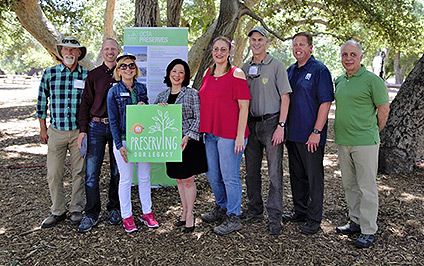
OCTA Directors Lori Donchak, also a San Clemente City Council member, and Lisa Bartlett, also Orange County’s Fifth District Supervisor (holding sign left to right) join with officials from OCTA, state and federal wildlife agencies, and local environmental leaders on June 20 to help commemorate an innovative program that protects more than 1,300 acres of open-space land from development in exchange for expedited permits for 13 freeway improvement projects. Photo courtesy of OCTA.
OCTA and Wildlife Officials
Preserve 1,300 Acres of Wilderness
The Orange County Transportation Authority joined with officials from federal and state wildlife agencies and local environmental leaders this month to announce the completion of plans to protect 1,300 acres of open space, ensuring that it remains free from development forever.
The event marked the culmination of more than 10 years of work between the agencies to finalize the plans related to the Measure M Freeway Environmental Mitigation Program, which protects natural habitat and rare animal and plant species in Orange County.
“This is an important milestone for Orange County following years of hard work and strong coalition building between OCTA, state and federal officials, and local environmental community leaders who all care deeply about preserving our wildlands for generations to come,” said OCTA Director Lori Donchak, who chairs the Environmental Oversight Committee.
The certification of the final conservation plans, known as the Natural Community Conservation Plan/Habitat Conservation Plan and the associated environmental impact report, is the culmination of OCTA’s work with both the U.S. Fish and Wildlife Service and the California Department of Fish and Wildlife.
“Our work with OCTA, the state and other partners to develop this plan is an example of proactive conservation planning the U.S. Fish and Wildlife Service is spearheading across Southern California,” said Paul Souza, Regional Director of the Wildlife Service’s Pacific Southwest Region. “This plan provides assurances that crucial transportation projects can go forward efficiently while safeguarding Orange County’s priceless natural resources.”
OCTA’s freeway environmental mitigation program allocates funds from Measure M, the county’s half-cent sales tax for transportation improvements, to acquire land and fund habitat restoration projects in exchange for streamlined approvals for 13 freeway improvement projects throughout Orange County.
The program is a comprehensive effort to offset the environmental impacts of the freeway construction projects in Measure M by preserving large swaths of valuable habitat, to protect the plant species and rare animals that live on the land and provide connectivity to other natural lands.
Through the environmental program, OCTA has acquired seven parcels of natural land previously slated for development in Trabuco Canyon, Silverado Canyon, Brea and Laguna Beach from willing sellers for the purpose of preserving it.
Approximately $10 million in funding also has been made available for 11 habitat restoration projects, totaling nearly 350 acres.
Overall, approximately $280 million is expected to be made available for environmental conservation projects over a 30-year period. Another component of OCTA’s environmental program provides funding to cities for projects that help protect water quality in Orange County.
OCTA’s environmental efforts have been guided, in part, by the participation of the Environmental Oversight Committee, consisting of a dozen public members who make recommendations to the OCTA board of directors, who sent the plans to the federal and state wildlife agencies for final approvals.
“We’re proud of the example we’ve set through this process in both enhancing our transportation system and protecting the valuable natural environment that makes Orange County such an attractive place to live,” said OCTA CEO Darrell Johnson. “We continue to fulfill the promises we made to the county’s voters in Measure M and we hope the others in the state will follow this innovative and cooperative effort.”
With the final environmental approvals in place, OCTA staff will continue to work toward completing Resource Management Plans for each of the preserves, which also will outline potential public access to the properties that is safe and compatible with the biological goals.
Those individual plans for each preserve are being finalized. In the meantime, OCTA continues to host periodic hikes and equestrian rides on some properties.
The OCTA board last year initiated an endowment fund that will ensure the long-term management and maintenance of the preserves to protect their valuable biological resources.
OCTA will continue to work toward designating appropriate long-term managers for the preserves while identifying and funding new restoration projects.
For more information on OCTA’s environmental program, visit octa.net/environmental.
SANDAG Closes on Federal Loan for Trolley Project
 SANDAG completed the process of securing a large loan under a federal credit assistance program this month to help finance the construction of the Mid-Coast Trolley Extension, providing very low borrowing costs and flexibility that will save taxpayer dollars in building the largest transit project in the region’s history.
SANDAG completed the process of securing a large loan under a federal credit assistance program this month to help finance the construction of the Mid-Coast Trolley Extension, providing very low borrowing costs and flexibility that will save taxpayer dollars in building the largest transit project in the region’s history.
The federal Transportation Infrastructure Finance and Innovation Act (TIFIA) program offers opportunities to support and facilitate the financing of large and complex transportation projects. It provides federal credit assistance for qualified projects of national and regional significance, and typically provides more advantageous terms than can be obtained in the traditional financial markets.
SANDAG closed on a 2.72 percent fixed-rate loan of up to $537.5 million from the program, which is administered by the Build America Bureau within the U.S. Department of Transportation.
The Mid-Coast project, which is currently under construction, will add nine new stations and extend San Diego Trolley service for 11 miles from Old Town up to UC San Diego and University City. It is expected to go into service in 2021.
The cost of the $2.1 billion project is being split between the federal New Starts Program, which has committed $1.04 billion, and the region’s TransNet program, the local half-cent sales tax for transportation administered by SANDAG. In order to finance large-scale projects, SANDAG sells bonds against future TransNetrevenues. The TIFIA loan provides lower rates and more flexibility in that process.
TRANSPORTATION EVENTS IN THE COMMUNITY
Thursday, July 13
CMAA SoCal: Breakfast of Champions Featuring Metrolink
More | Register
Thursday, July 20
CMAA SoCal: Breakfast of Champions – I-710 South Project
More | Register
Thursday, July 20
OCBC: 2017 Economic Development Forum
More | Register
Tuesday, July 25
BDA-IE: SR210 Lane Addition & Baseline Interchange Design & Construction
More | Register
Wednesday, July 26
WTS-LA: Reception Welcoming New Port of Long Beach Executive Director, Mario Cordero
More | Register
Sept. 18-20
ITS-CA: Annual Conference and Expo
More info | Register
Tuesday, Sept. 19
OCBC: Executive Invitational Golf Tournament
More info | Register
Thursday, Oct. 5
AAa/e: Annual Banquet
More
Oct. 29-31
Self-Help Counties Coalition: Focus on the Future
More info | Register
Nov. 8-10
CTA: Annual Fall Conference
More info
Have a transportation-related event you want people to know about? E-mail Kristin Slocum or call 949.288.6884 to have your event listed in our next ForwardMotion.

